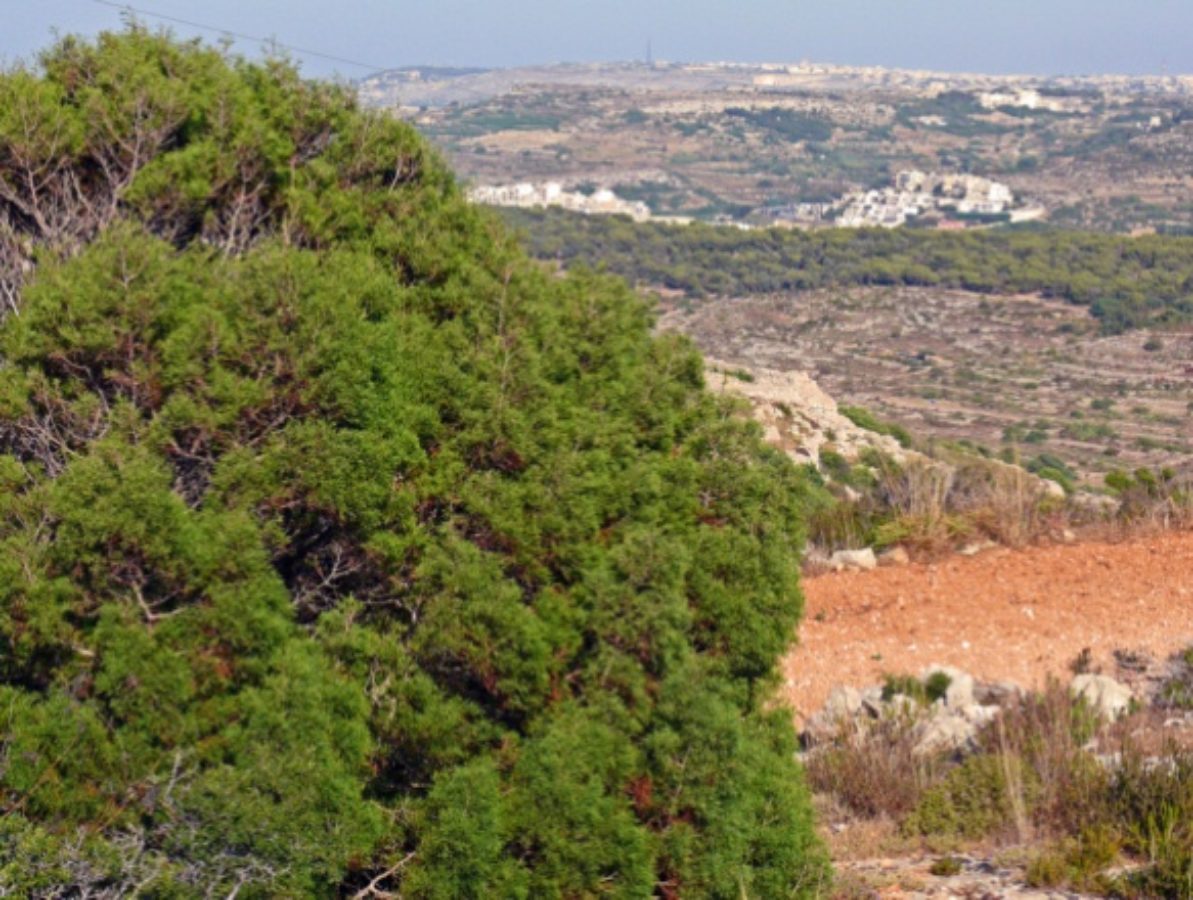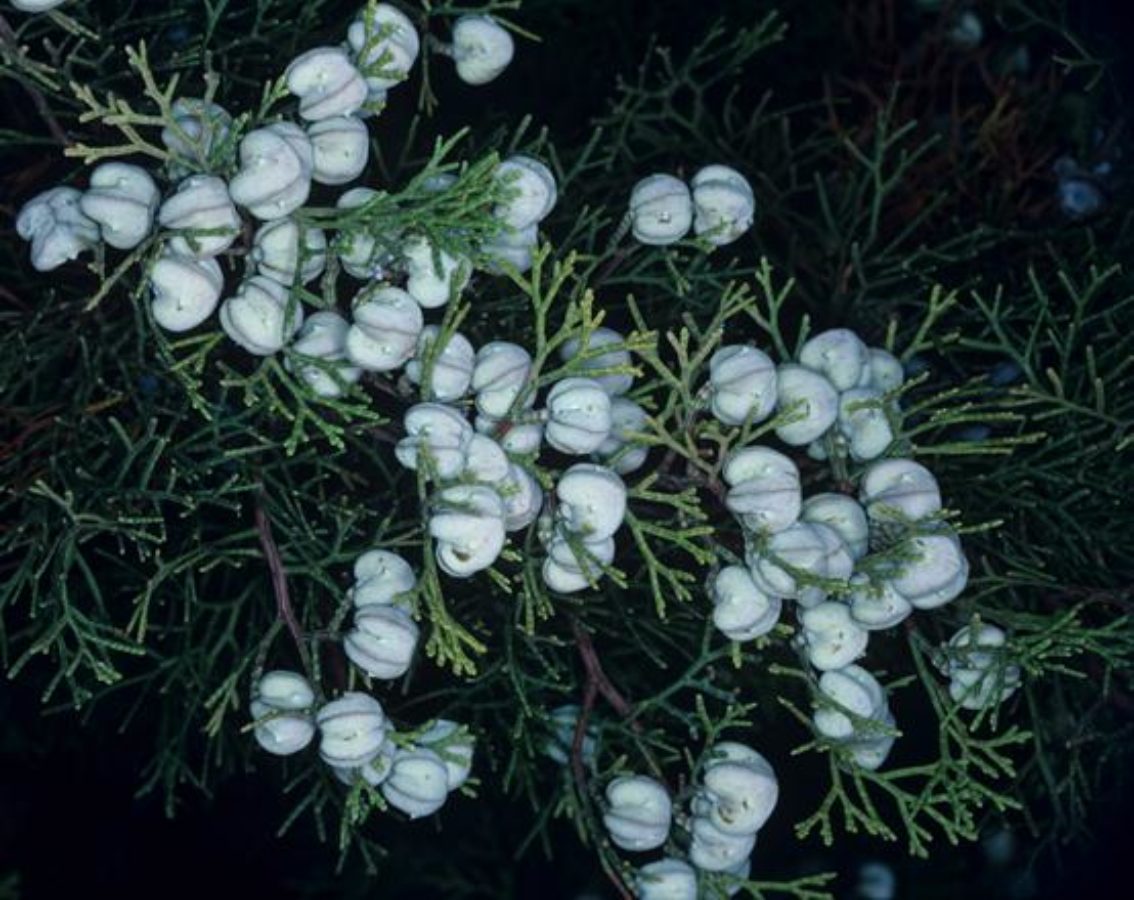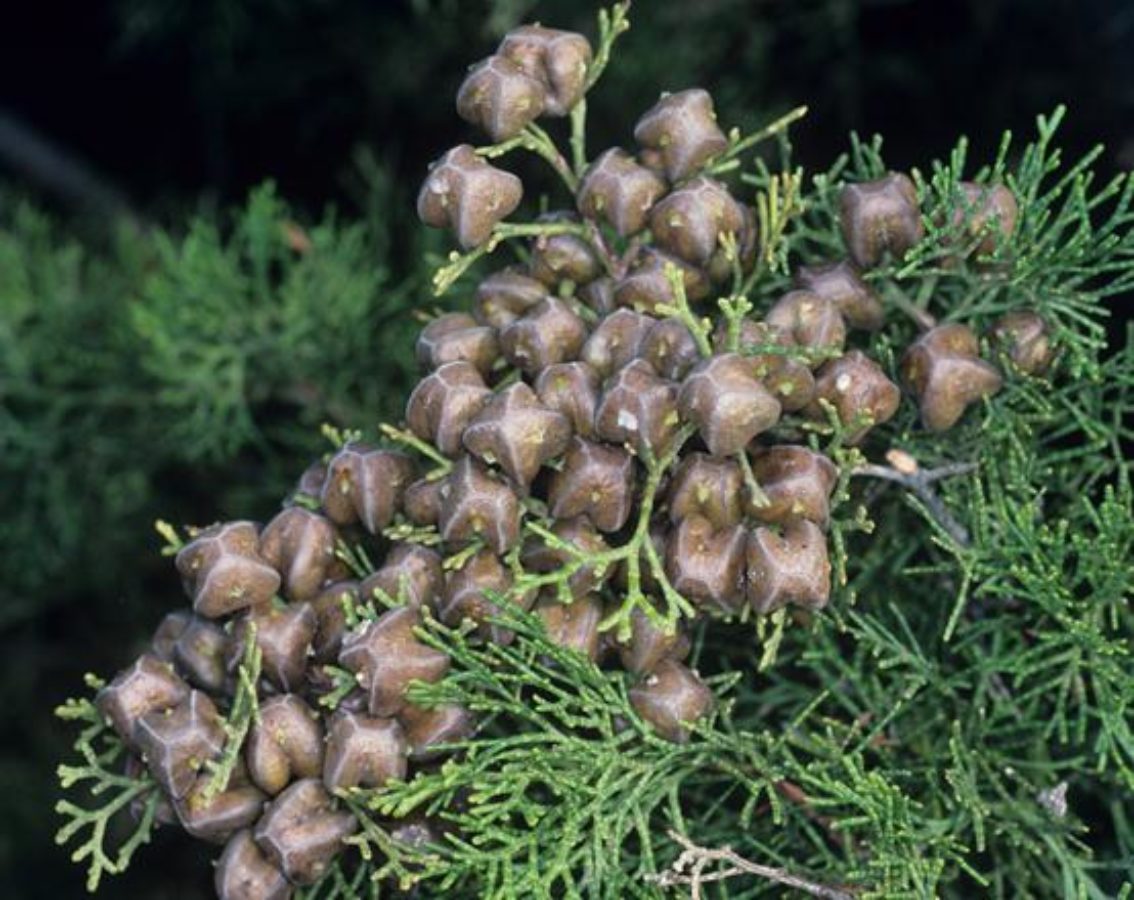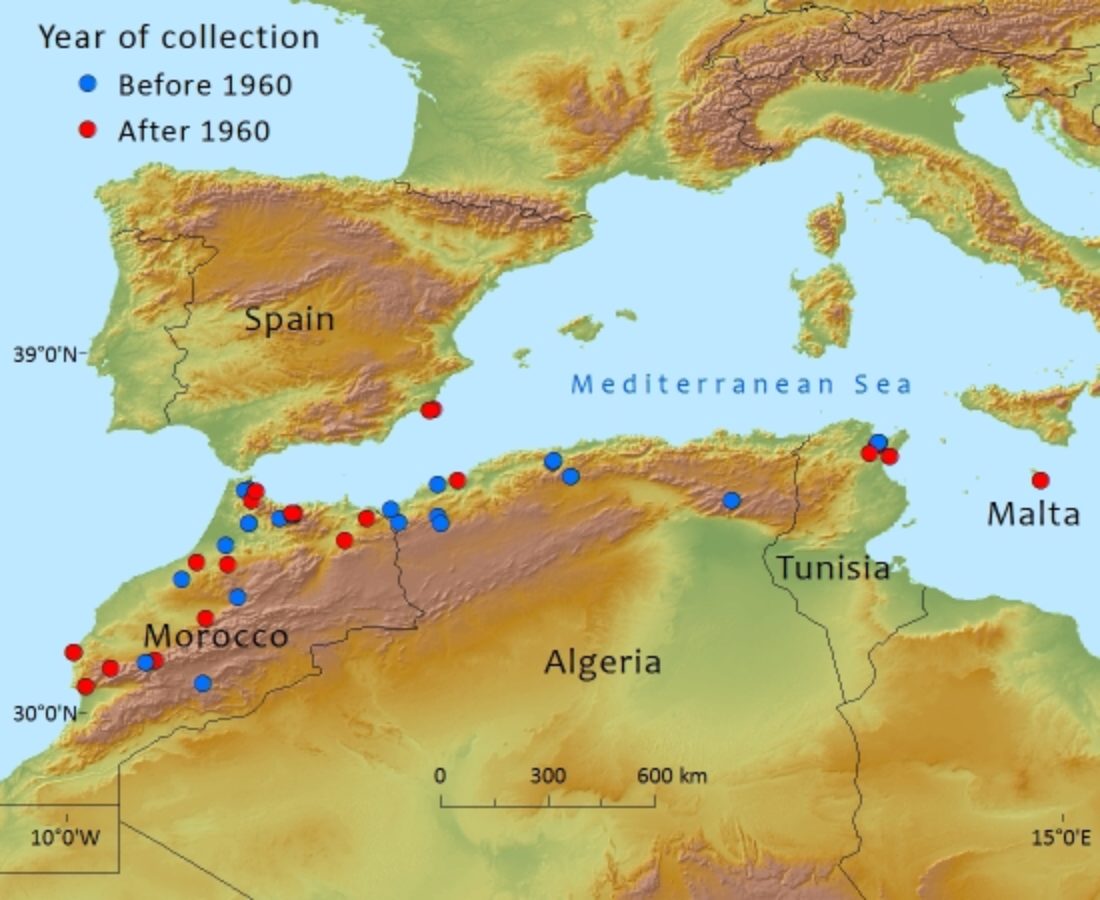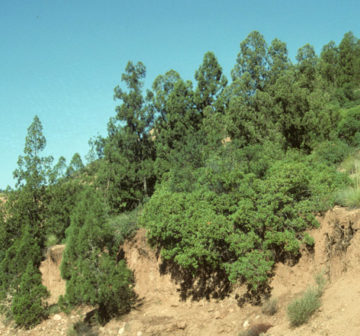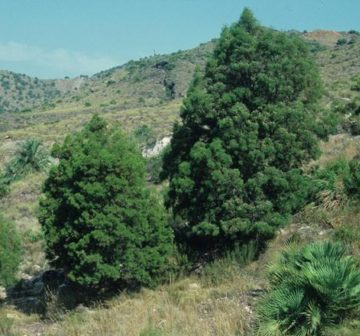Cupressaceae
Tetraclinis articulata
A genus with a single species endemic to the western Mediterranean where, although not globally threatened, it is Critically Endangered in Spain and Malta due to fire and grazing.
Description
Habit
Shrub or small monecious tree 6–15m tall, evergreen, with a pyramidal habit in immature plants, irregular when older; trunk often multistemmed and coppicing from base. Bark with small, thick, angular scaly plates or exfoliating in longitudinal flakes; greyish–brown weathering dark or ash–grey, cinnamon beneath when exposed.
Foliage
Branches articulate, branching alternately at different angles, flat, forming open ‘sprays’. Leaves 1.6–8 x 1–1.5cm, decussate, borne in whorls of 4mm, scale–like.
Cones
Female cones 0.6–1.2cm, angular globose, with four thick scales arranged in two opposite pairs, green at first and ripening brown and sometimes covered with a very distinctive pure white blume. Male cones, solitary, ovoid–globes, ca. 4 x 2.5mm, reddish, maturing yellowish–brown.
Human Uses
Historically the wood has been used for making yokes (for use in mines) and for the construction of houses. Due to its unusual grain and rich colour, burr-wood (known as Thuja-burr) has in recent years become increasingly popular especially for kitchen utensils and household ornaments. Large burls, sometimes weighing in excess of 450 kilos, are produced underground as a result of repeated coppicing following fire, grazing or cutting. Overharvesting in Morocco has led the government to ban the export of the wood. Resin from the wood, known as sandarac gum, is used to make liquor and in Morocco it is used as a remedy for difficult childbirth. It is has many other uses including the treatment of cramps, roundworm, tapeworm and insomnia.
References and further reading
- Abela, G.F. (1647). Della descrittione di Malta: isola nel mare Siciliano con le sue Antichità, ed altre Notizie. Malta: Paolo Bonacota, xiv + 573 pp. Printed as a facsimile edition in 1984 by MidSea Books Ltd. (Malta) as the Melitensia Book Club Issue no. 1.
- Ayyad, M. A. (2003). Case studies in the conservation of biodiversity: degradation and threats. Journal of Arid Environments. 54, 2003, pp. 165–182.
- Borg, J. (1927). Descriptive Flora of the Maltese Islands. Malta: Government Printing Office. 846 pp.
- Esteve-Selma, M.A.,Martínez-Fernández, J., Hernández, I., Montávez, J.P., Lopez, J.J., Calvo, J.F. & Robledano, F. (2010). Effects of climatic change on the distribution and conservation of Mediterranean forests: the case of Tetraclinis articulata in the Iberian Peninsula. Biodiversity & Conservation. 19(13): 3809-3825.
- Fennane, M. (1988). Tetraclinis formations of Morocco: Syntaxonomy and key to associations. Documents Phytosociologiques. 11: 303-310
- García Martínez, M. S., Grau Almero, E. & Ros Sala, M. M. (2008). El paisje vegetal Pre- y Protohistórico de la costa de Mazarrón (Murcia) según el antracoanálisis de punta de los Gavilanes. Rev. Quaternary & Geomorphology. 22(3-4): 107-120.
- Gardner, M.F. & Jury, S.L. (1993). Tetraclinis articulata. The Plantsman. 15(1): 54-59
- Hadjadi, S., Aoul, M. Chouieb, M. & Loisel, R. (2009). Effet des facteurs environnementaux sur les premiers stades de la régénération naturelle de Tetraclinis articulata (Vahl, Master) en Oranie, Algérie. Effect of environmental factors on natural regeneration of Tetraclinis articulata (Vahl, Master) in Oran region, Algeria. Revue internationale décologie méditerranéenne. 35: 19-31
- Houerou, H.N. (1969). Le végétation de la Tunisie steppique. Annales de l'Institut National de la Recherche Agronomique de Tunisie. 42(5): 620.
- Ibanez, J.M. et al. (1989). Data on a population of Tetraclinis articulata (Vahl) Masters. Ecologia. 3: 99-106
- Lanfranco E.: (1989). The Flora. Red Data Book for the Maltese Islands (eds. Schembri P.J.; Sultana J.). Department of Information, Malta, p.5-70
- Lamnauer, D. (2005). Tetraclinis articulata. A Guide to Medicinal Plants in North Africa, pp. 269-272. IUCN Centre for Mediterranean Cooperation, Malaga
- López-Hernández J. (2000). Respuesta ambiental de las principales especies arbustivas en sistemas áridos y semiáridos mediterráneos: Modelos y Aplicaciones. Thesis doctoral;. Universidad de Murcia.
- López-Hernández, J, Calvo, J, Esteve-Selma, M. & Ramírez-Díaz, L. (1995). Respuesta de Tetraclinis articulata (Vahl) Masters al fuego. Ecología. 9: 213-221
- Medjahdi, B., Ibn Tattou, M., Barkat, D. & Benabedli, K. (2009). La Flore Vasculaire Des Monts Des Trara (Nord Ouest Algérien). Acat Botanica Malacitana 34: 1
- Ministère de l´Agriculture, Direction Générale des Forêts (1995). Résultats du premier inventaire pastoral national en Tunisie. 154 p
- Moore, H. M., Fox, H. R., Harrouni, M. C. and El Alami, A. (1998). Environmental challenges in the Rif mountains, northern Morocco. Environmental Conservation. 25(4): 354-365.
- Moreno, J.C. (coord.). (2008). Lista Roja 2008 de la Flora Vascular Española. Dirección General de Medio Natural y Política Forestal (Ministerio de Medio Ambiente, y Medio Rural y Marino, y Sociedad Española de Biología de la Conservación de Plantas), Madrid.
- Nicolás, M.J., Esteve, M.A., Palazón, J.A. and Hernández, J.J.L. (2004). Modelo sobre las preferencias de hábitat a escala local de Tetraclinis articulata (Vahl) Masters en una población del límite septentrional de su área de distribución. Anales de Biología. 26: 157-167.
- Sánchez Gómez, P., Carrión, MÁ., Hernández, A. & Guerra, J. (2002). Libro rojo de la flora silvestre protegida de la Región de Murcia. Vol. I,(II). Consejería de Agricultura, Agua y Medio Ambiente. Dirección General del Medio Natural. Comunidad Autónoma de la Región de Murcia. 686 pp. Murcia.
- Schembri, P.J. & Sultana, J. (1989). Red Data Book for the Maltese Islands. Department of Information, University of Malta
- Sommier, S. (1906.) A proposito della Callitris quadrivalvis Ric. (Thuja quadrivalvis Vahl.) scoperta a Malta dal consocio Caruana-Gatto. Bulletino Della Società Botanica Italiana. (5-6):115.
- Stevens, D.T, & Baldacchino, A.E. (2000): Sigar Maltin, Sigar Barranin, il-Harsien taghhom u l-obbligi Nazzjonali u Internazzjonali. In: Baldacchino, A.E. & Stevens, D.T. (eds.) Is-Sigar Maltin: l-Uzu u l-Importanza, pp. 53-100. Malta: Environment Protection Department.
- Stevens, D.T. (1999) Legislation concerning the Protection and Conservation of Maltese Flora. In: Vujicic, R.; Lanfranco, E. & Vella, A. (eds.): SOS for Maltese Flora, pp. 57-74. Malta: Department of Biology of the University of Malta, Ministry for Agriculture and Fisheries & the Environment Protection Department
- Stevens, D.T. & Gambin M.T.(2007/08). Reporting on the ‘main results of the surveillance under Article 1’ for Annex 1 habitat types (9570 - Tetraclinis articulata Forests)
- Templado, J. (1975). El arara, Tetraclinis articulata en las Sierras de Cartagena. Bol. Estac. Centr. Ecol. 3(5): 43-56.

